Looking for things to do in Buenos Aires when it rains? Here is a list of fun, indoor rainy day activities you can enjoy across the city!
Buenos Aires is a city that thrives in all seasons, even when the skies turn grey. Having spent many rainy days exploring the Argentine capital, I’ve discovered that some of its most memorable experiences happen indoors, away from the umbrella-toting crowds.
From historic palaces and grand theatres to cozy cafés and world-class museums, Buenos Aires offers endless ways to connect with its culture, architecture, and history, no matter the weather.
In this guide, I’ll share 15 of the best rainy day activities in Buenos Aires, like touring palaces, lingering in bares notables, taking a cooking class, exploring art galleries, shopping for leather goods, browsing beautiful bookstores, and so much more.
Things to do in Buenos Aires on a Rainy Day
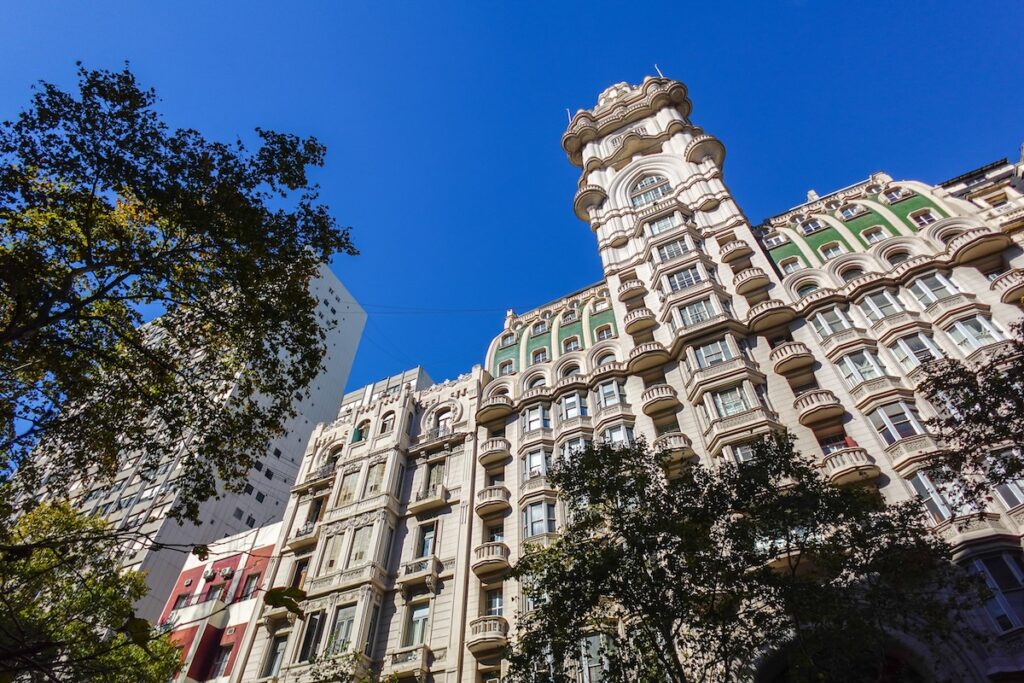
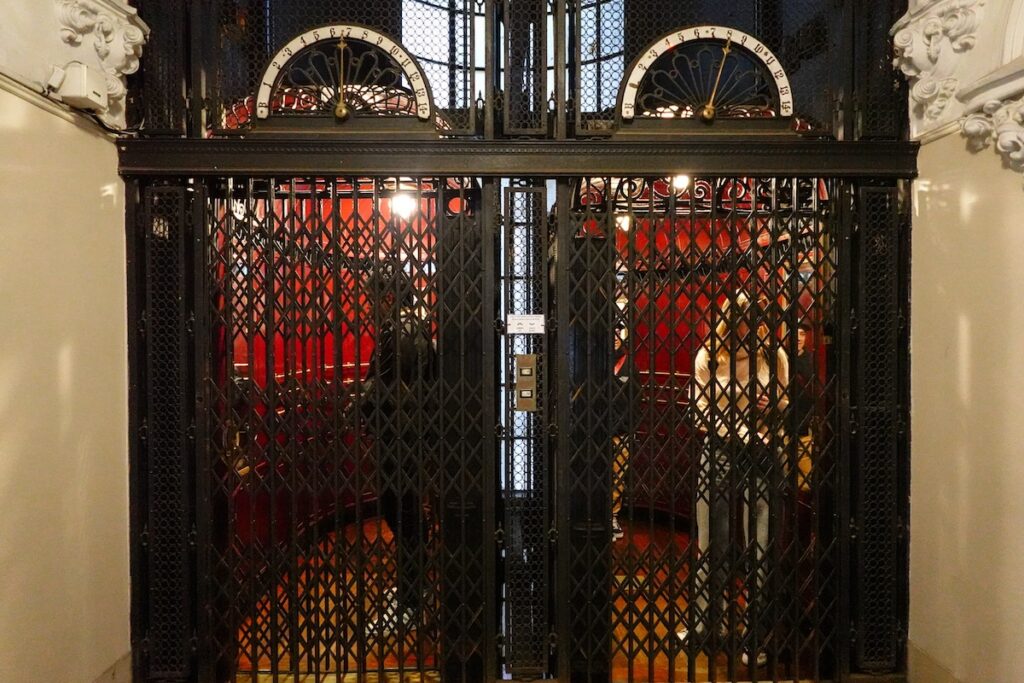
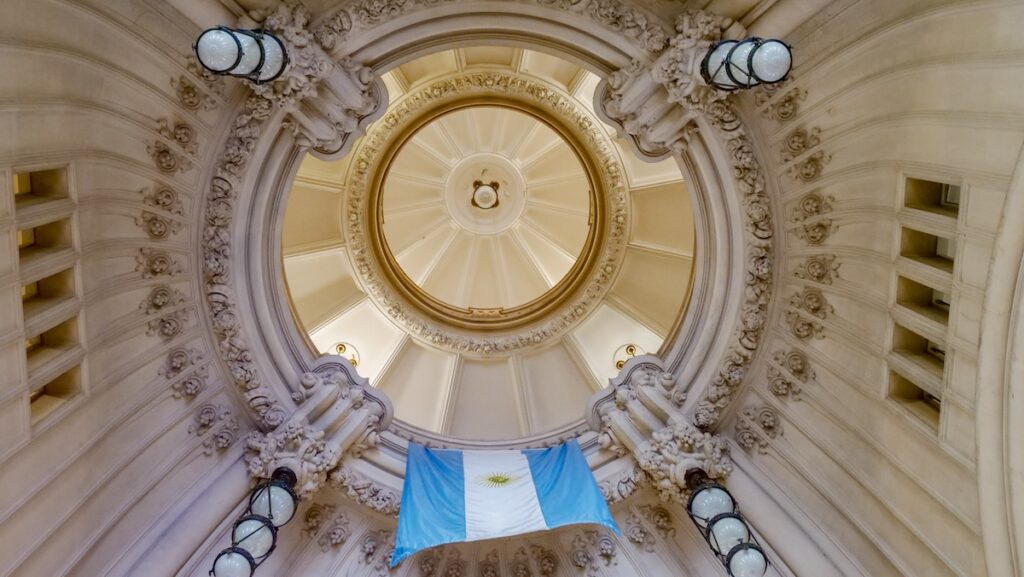
1. Explore Palacio Barolo’s architecture
A fun rainy day activity in Buenos Aires is to join a guided visit of Palacio Barolo. Not only does this 100-metre-tall building offer panoramic views of the whole city, but its design was inspired by Dante Alighieri’s Divine Comedy. That means visiting this building is an architectural journey through Hell, Purgatory, and Heaven.
Hell and Purgatory can be reached by elevator, however, to reach Heaven, you have to climb a spiralling staircase for the last 8 floors. The reward is the glass lighthouse atop Palacio Barolo, which offers 360-degree views of the whole city. It’s truly spectacular, and I think it’s something that you can enjoy rain or shine.
As a bonus, you may want to tack on a visit to Salon 1923, a rooftop bar located inside Palacio Barolo. The east and west-facing terraces may be closed because of the rain, but that doesn’t mean you can’t enjoy the indoor space in all its 1920s glory.
We had walked past Palacio Barolo in Monserrat so many times on our countless visits to Buenos Aires, and I can’t believe it took us so long to finally visit! It’s a really fun tour and a great way to explore an iconic landmark in the city.
You can book your guided tour of Palacio Barolo here. Tours are bilingual (English and Spanish) and run 1.5 hours in length.


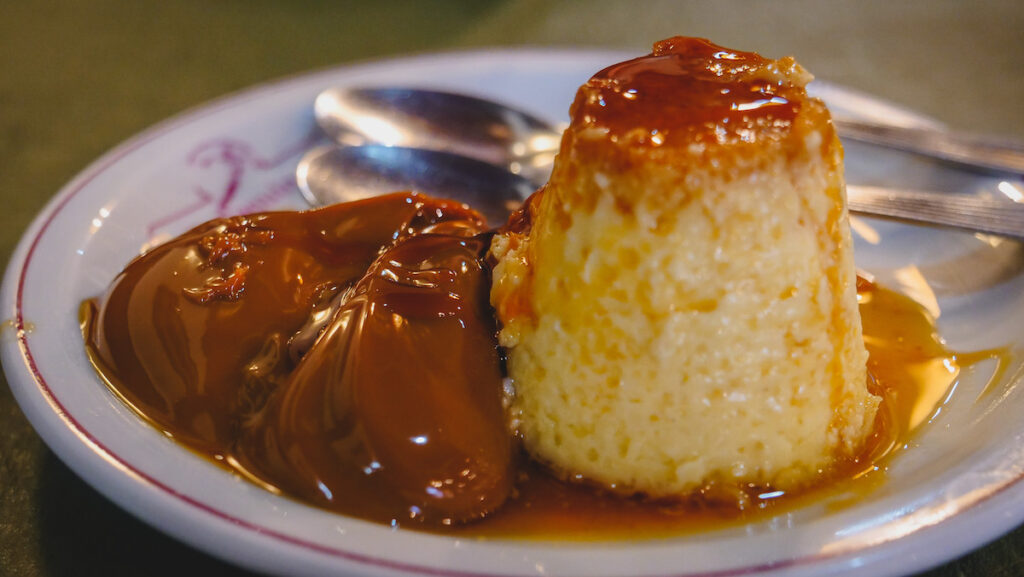
2. Take an Argentine cooking class
I’m a big fan of taking cooking classes whenever I travel. In part, because I love to eat, but also, what makes for a better souvenir than learning to make a recipe and taking it back home with you?
There are loads of Argentine cooking classes to choose from in Buenos Aires; you can learn to make empanadas, alfajores, or even multi-course meals.
This Pachamama cooking class is a particularly popular one, and it’s a feast where you get to prepare a four-course local menu while learning about the history and origin of these traditional Argentine dishes.
You’ll be welcomed with a picada (a snacking spread) and a vermouth cocktail because you can’t get to work in the kitchen if you’re feeling hungry.
Then, you dive into the different recipes, including chipá, a starchy bread with Guaraní roots; empanadas, dough pastries typically stuffed with meat; humita, an Andean corn dish that can be served in a corn husk or in a casserole; and dulce de leche crepes. All of this paired with wine!
You can book your Pachamama Argentine cooking class here. This class runs 3.5 hours and is consistently rated as a 5-star cooking experience by visitors.
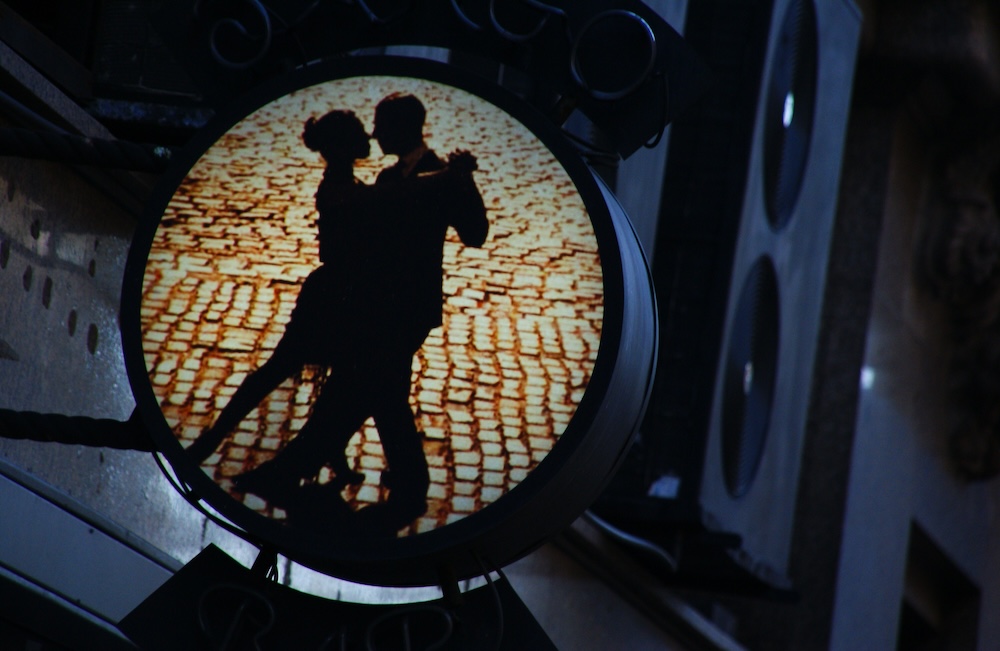
3. Go to a tango and dinner show
Going to a tango show is a quintessential part of any trip to Buenos Aires. This is the birthplace of tango, so of course you need to make time to go to at least one show!
Here’s a list of some of the best tango shows in Buenos Aires, with each one offering something a little bit different. There are tango shows that include folklore dancing, shows that have more of a cabaret style, and big stage productions with a Broadway flair.
Whenever I have friends or family visiting Argentina, this is one of the first activities I recommend. It’s just a really fun introduction to Argentine culture!
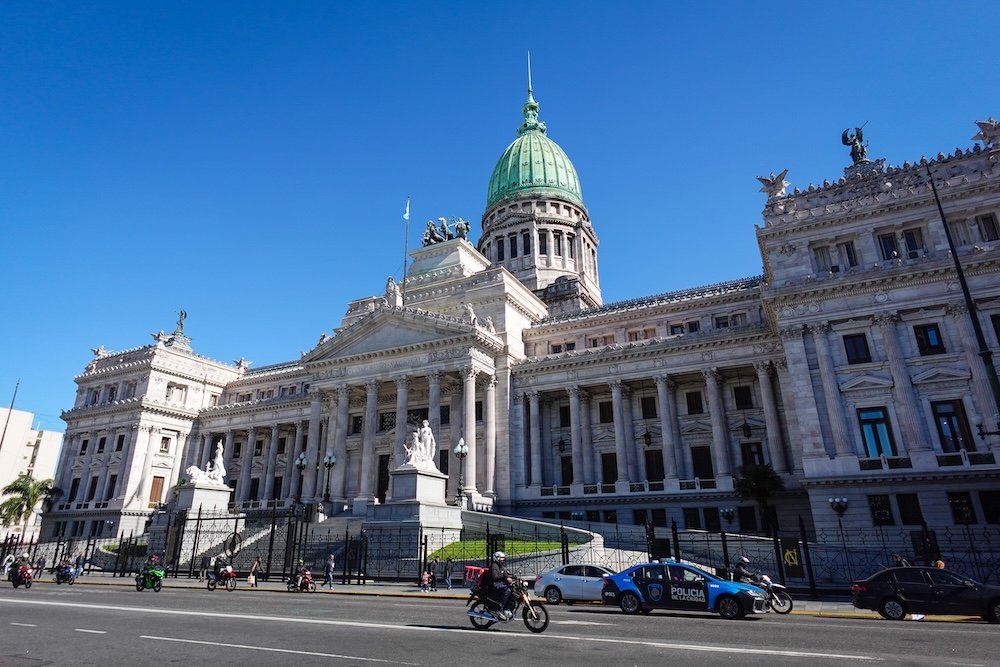


4. Tour the National Congress of Argentina
Another thing to do in Buenos Aires when it rains is to join a guided visit of the National Congress of Argentina.
The National Congress is composed of the Senate with 72 seats and the Chamber of Deputies with 257 seats. This means it is bicameral and its ordinary sessions run from March 1 to November 30.
The building itself is spectacular both inside and outside. The guided visit ran 1 hour in length and we got to visit both the Senate and the Chamber of Deputies, as well as numerous salons. We were divided into 2 groups: one with an English-speaking guide and another with a Spanish-speaking guide.
It was a super informative visit and we lucked out with an amazing guide who shared a wealth of information, answered all our questions, and shared plenty of fun facts along the way. The hour flew by!
Visiting the Argentine National Congress does take a bit of luck. In theory, guided tours run Monday to Friday at 12:00 and 17:00. However, in practice, these tours can be cancelled at the very last minute if there is parliamentary activity.
We tried visiting a few times during our many visits to Buenos Aires, and it took us a couple of attempts before our dates aligned with the guided visits.
I would recommend checking the official Senate website on the day of your visit. Scroll down to Agenda de Actividades (Activities Agenda) on the homepage and check if there’s a listed Visita guiada al Palacio Legislativo (Guided visit of the Legislative Palace) for your desired date.
You’ll then want to make your way to Hipólito Yrigoyen 1863 (the third door on the south entrance of the National Congress) and arrive 30 minutes before the tour, as they accept a maximum of 30 people on this guided visit. You cannot reserve ahead of time.
To take part in this visit, you’ll have to present your ID (either a passport or DNI), have your photo taken, and go through security.

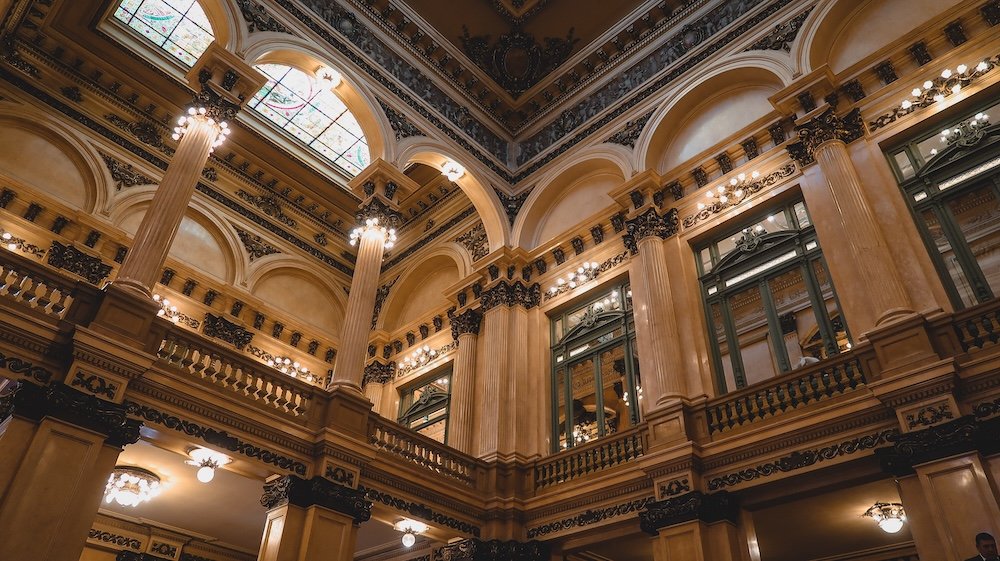
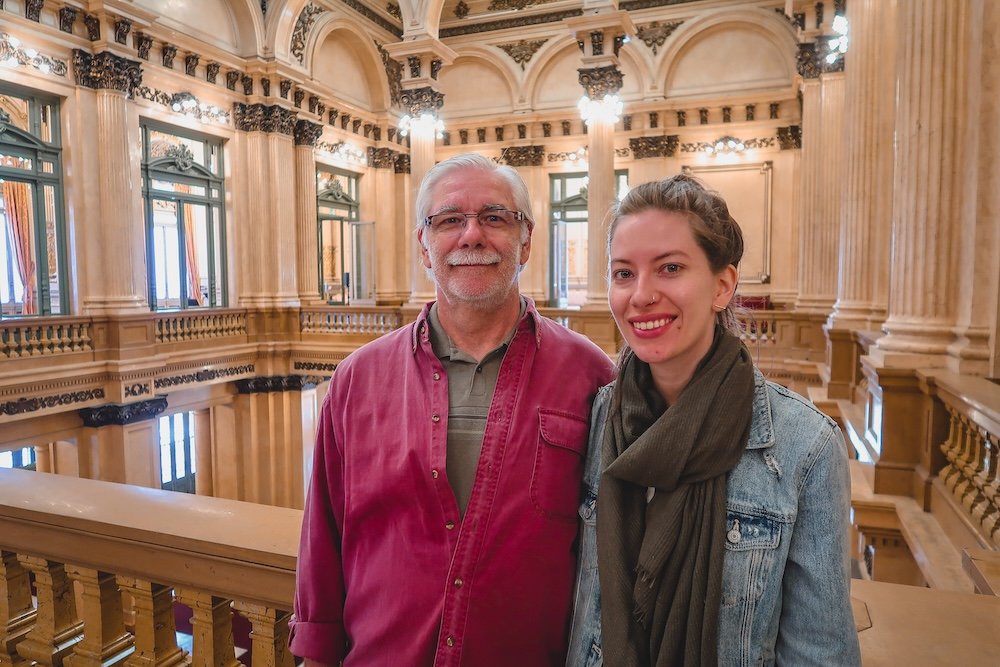
5. Visit Teatro Colón
Another iconic Buenos Aires attraction I’d recommend visiting during your time in the city is Teatro Colon. This is a great rainy day activity as you’ll be indoors.
Teatro Colón is an opera house that overlooks Avenida de Julio and first opened its doors in 1908. Opulent is one way to describe this building; it truly feels like you’re walking through a French palace!
Many of the materials were brought over from Europe, including different types of Italian marble, French stained glass, and Venetian mosaics.
The auditorium is shaped like a horseshoe with seven tiers that hold 2,487 velvet seats and standing room for 1,000. It’s the kind of building that will take your breath away!
While Teatro Colon is an architectural work of art, what sets it apart is its acoustics! The opera has continuously been listed as having some of the best acoustics for operas and concerts.
The great Italian tenor Luciano Pavarotti once said, “The acoustics have the greatest defect: they are perfect! Imagine what this signifies for the singer: if one sings something bad, one notices immediately.”
If a guided visit of Teatro Colon is not enough (you may very well want to come back for a performance after seeing its beauty!), you can check out their program, including ballet, opera, philharmonic orchestra, and many other concerts.
Lastly, if you’re feeling a bit peckish after your visit, I recommend walking one block over to Petit Colón. This is one of my favourite historic cafes in Buenos Aires and I go at least once whenever I’m in the city.

6. Visit Casa Rosada
Casa Rosada, or the Pink House, is the executive mansion and office of the President of Argentina. Also known as the Government House or Casa de Gobierno, this building sits on the east end of the Plaza de Mayo.
The Casa Rosada is known for its Italianate architecture and unique pink colour. “Why pink?”, you might ask.
Well, the building’s hue is a combination of red and white, representing the colours of the opposing political factions in 19th-century Argentina; the Federals used red while the Unitarians used white.
Another explanation you might hear is that at one point, the Pink House was painted with cows’ blood, a supposed alternative to paint that wouldn’t peel in the humidity!
The interior of the Casa Rosada features grand halls, beautiful staircases, and historic rooms like the Salón de los Bustos, where busts of former presidents are displayed.
The building also has a stunning courtyard known as the Patio de las Palmeras, filled with palm trees and statues.
Aside from touring Casa Rosada, you can also visit Museo Casa Rosada, a museum located underneath the presidential palace. It covers more than 200 years of Argentine history from the May Revolution of 1810 to the present day.
I ended up visiting this museum on a rainy day in Buenos Aires, having walked past the Casa Rosada countless times! The museum holds presidential cars, portraits and documents. Plus, the building itself is a time capsule where you can see the old brick walls of the original fort and customs building.
Note: Casa Rosada is not currently open to visitors (only guided school visits). When it does re-open to the general public, you’ll be able to click through Visitas Casa Rosada. They typically offer free guided tours in both English and Spanish. You will need your passport to enter.
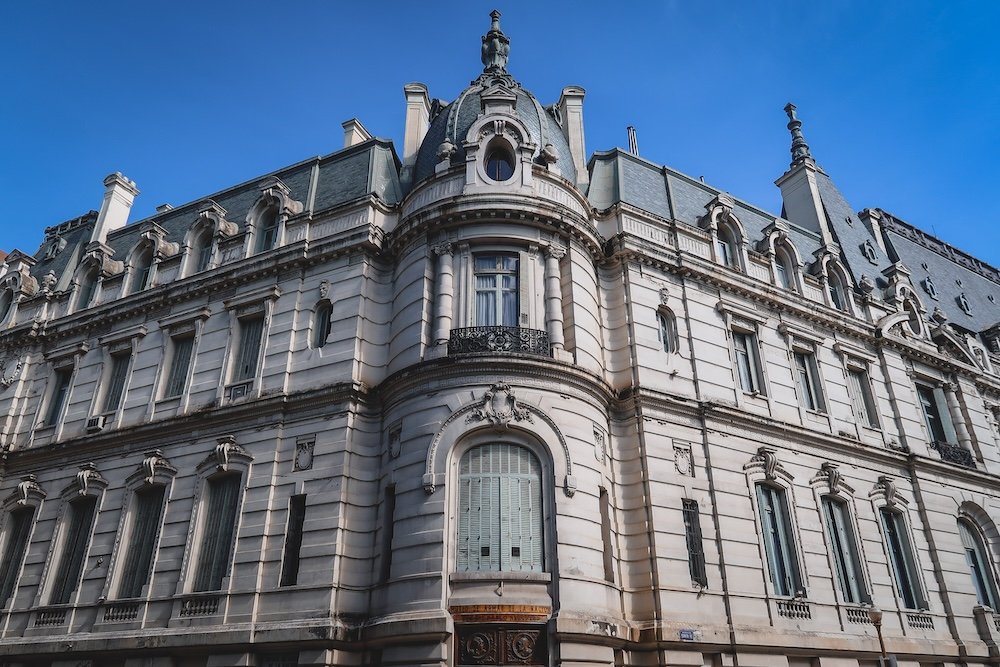


7. Marvel at Argentine Palaces
Buenos Aires is often called the “Paris of South America,” and nowhere is this more evident than in its collection of elegant palaces and grand mansions built during the city’s Belle Époque, during the late 19th to early 20th century.
During this period, Argentina’s elite, enriched by booming agricultural exports, sought to display their wealth by commissioning European architects and importing materials from France and Italy to construct opulent urban residences.
Many of these palaces line the avenues of Recoleta, Retiro, and Palermo, showcasing ornate façades, wrought-iron balconies, marble staircases, and sprawling ballrooms inspired by Parisian and Neoclassical styles.
While some have been transformed into embassies, cultural centers, or luxury hotels, others remain private family homes, lending an air of grandeur to everyday city streets.
Over the years, I’ve been able to visit a few of these Argentine palaces, like Palacio de Aguas Corrientes, which houses the Water Works Museum; Palacio Paz, which is home to the National Arms Museum; and Palacio Alvear, where I’ve had afternoon tea.
Pick a few palaces to visit, and you have a great Buenos Aires rainy day activity.
8. Zanjon de los Granados
El Zanjón de los Granados is one of Buenos Aires’ most fascinating hidden treasures, offering a journey beneath the city streets into layers of urban history.
Located in San Telmo, this site was uncovered in the 1980s when a local family began restoring a dilapidated 19th-century mansion and accidentally discovered a network of brick tunnels, cisterns, and foundations dating back to the early colonial period.
The tunnels once carried the Zanjón stream, one of the city’s earliest watercourses, before being enclosed and built over as Buenos Aires expanded.
Today, guided tours take visitors through the subterranean passageways, revealing archaeological remnants, restored architecture, and exhibits that trace the city’s evolution from the 1500s onward.
It’s an excellent rainy day activity because the experience is indoors, combining shelter with a deep dive into one of Buenos Aires’ lesser-known attractions.
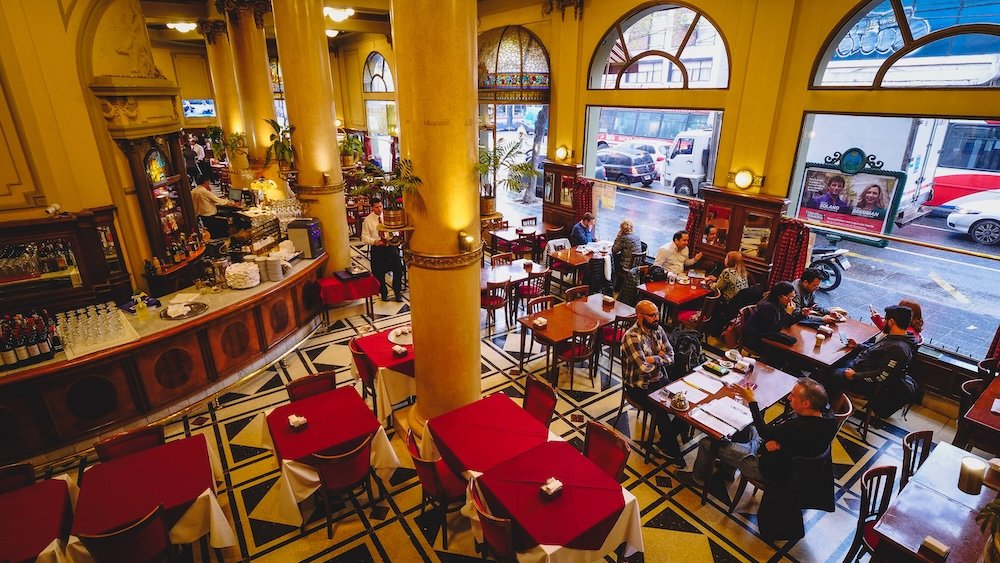

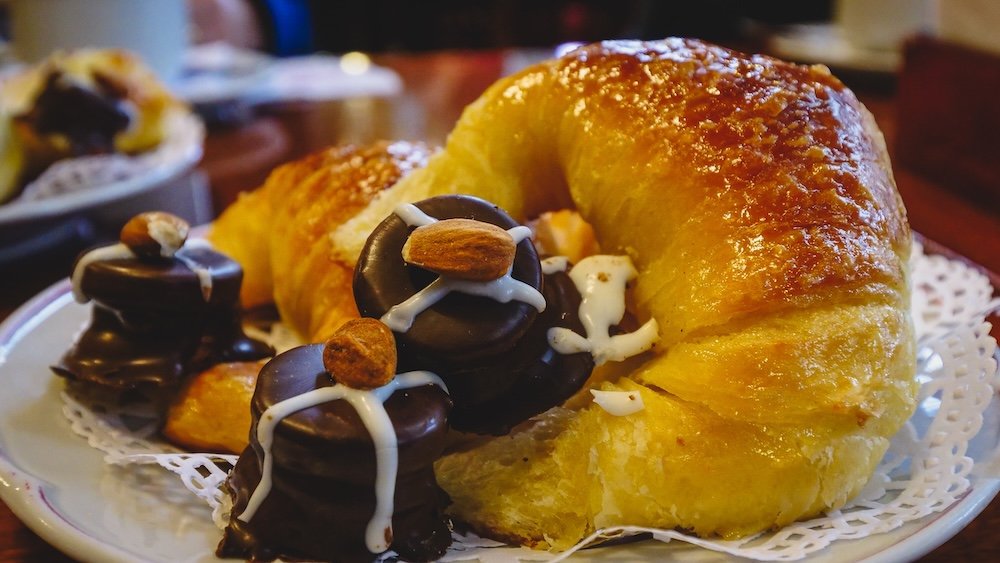
9. Visit the Bares Notables
Ducking into one of the city’s bares notables, or notable bars, is another great rainy day activity in Buenos Aires.
The city government has officially recognized these historic cafés, bars, and bistros for their cultural, architectural, or historical significance. Many date back to the late 19th and early 20th centuries, when Buenos Aires was flourishing as a cosmopolitan hub and European immigrants shaped its café culture.
Think high ceilings, marble-topped tables, wooden counters, vintage mirrors, and the lingering atmosphere of literary gatherings and political debates.
Visiting a bar notable isn’t just about grabbing a coffee, but rather about soaking up a piece of porteño history. You can expect a relaxed, old-world ambiance, attentive service, and some even have live music and tango performances in the evenings.
Some of the most famous examples include Café Tortoni, Bar El Federal, and Los 36 Billares, each with its own unique story and character.
10. Shop at Galerias Pacifico
Galerias Pacifico is a historic shopping arcade that was designed in the French Beaux Arts style. It takes up an entire city block, and it is strikingly beautiful!
It was built in 1889 to house the Au Bon Marché department store, however, it never served its original purpose. Instead, it housed the Museo de Bellas Artes up until 1940. Then, in 1992, it became a shopping centre with lots of international brands as well as a food court.
But don’t dismiss this shopping centre, even if you don’t enjoy shopping! I’m not a huge shopper, but even I take the opportunity to walk through the galleries whenever I’m in the area.
Galerias Pacifico is more like a museum or an art gallery than a shopping centre, and it will immediately transport you to Paris. The crowning jewel is the central dome featuring hand-painted frescoes that depict a scene called Love or Germination of the Earth.
11. Enjoy the city’s many Art Galleries
If you’re looking for artsy things to do in Buenos Aires when it rains, then why not check out some of the city’s art galleries?
There are countless galleries to choose from for all tastes, but for the purpose of this article, I’m highlighting just 5 of the more famous ones.
- MALBA (Museum of Latin American Art) – MALBA stands for Museo de Arte Latinoamericano de Buenos Aires, and it’s an art museum located in Palermo. It showcases Latin American art from the 20th century to the present.
- MAMBA (Buenos Aires Museum of Modern Art) – MAMBA is the Museo de Arte Moderno de Buenos Aires, and it is located in the district of San Telmo in an industrial brick building. This art museum features over 7000 works by Argentine and international artists like Salvador Dalí, Henri Matisse, Joan Miró and Pablo Picasso.
- MACBA (Buenos Aires Museum of Contemporary Art) – MACBA is locally known as Museo de Arte Contemporáneo de Buenos Aires. This art museum is located in San Telmo, and it houses works of contemporary art from the 1980s onwards by both local and international artists.
- Museo Nacional de Bellas Artes – The Museo Nacional de Bellas Artes is located in the neighbourhood of Recoleta. The museum’s permanent collection has works by art greats like El Greco, Goya and Rembrandt, just to name a few. Plus, it has the biggest collection of Argentine art.
- National Museum of Decorative Art – This museum is set in a Neoclassical mansion that was designed by a French architect. It was once the home of two prominent figures of Argentine high society at the turn of the century. Today, this mansion-turned-museum houses an impressive collection of European and oriental decorative art ranging from the 14th to the 20th century. This includes furniture, tapestries, sculptures and more.
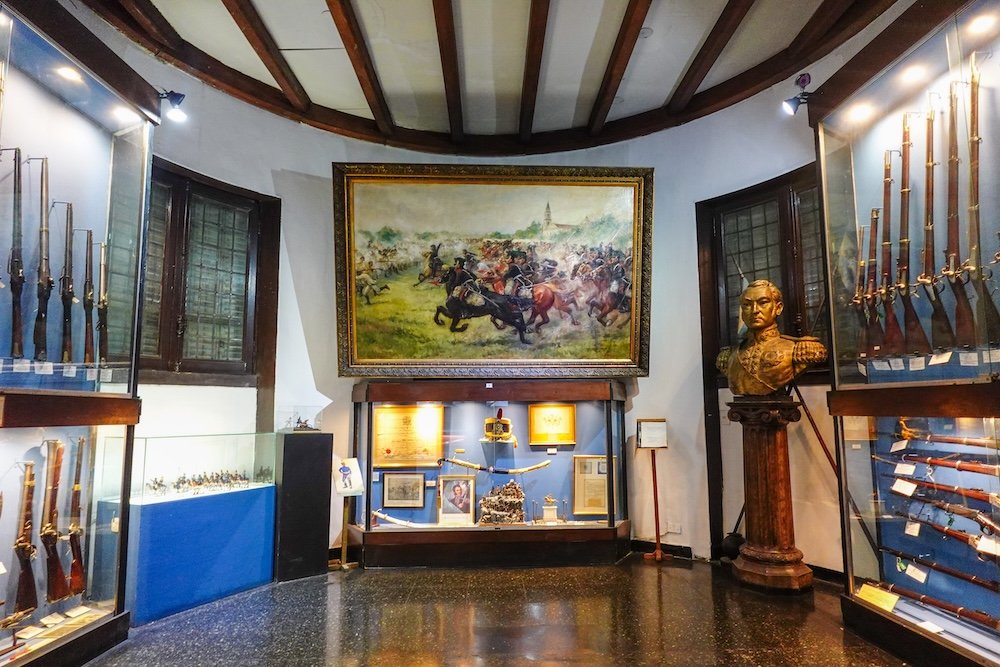
12. Spend the day Museum-hopping
Aside from art galleries, museums are another classic rainy day activity, even more so in Buenos Aires!
History lovers can dive into Argentina’s political and social past at the Museo Histórico Nacional, housed in a colonial mansion in San Telmo, where exhibits trace the country’s journey from independence to nationhood. We specifically visited this museum during one of our trips to Buenos Aires, so that my dad could see the Curved Sabre of San Martín, who was the liberator of Argentina, Chile and Peru.
Tucked away in the Abasto neighbourhood, the Museo Casa Carlos Gardel offers a glimpse into the life of Carlos Gardel, Argentina’s most iconic tango singer. The museum is housed in the very home where Gardel lived with his mother before his rise to fame. Inside, visitors can explore personal artifacts, original photographs, vintage records, and film posters.
Lastly, one of my favourite museums has recently been the Museo de Armas de La Nación. Housed within the Circulo Militar, a grand Beaux-Arts palace once belonging to the Paz family, the museum holds one of the most impressive weapons collections in South America. When we first walked in, I was surprised to see medieval suits of armour and swords from across Europe! We then moved on to galleries filled with firearms, cannons, uniforms and other Argentine military relics. Once again, this is another one of those museums that I had walked past countless times! I visited on a whim because my dad was interested in seeing it, and it proved to be a hidden gem.
13. Shop for leather goods
Another fun way to spend a rainy day in Buenos Aires is to go shopping for leather goods. Argentina is world-renowned for its high-quality leather with countless boutiques selling leather jackets, leather handbags, leather shoes and more.
Calle Florida has the highest concentration of leather stores in Buenos Aires, so that’s a good place to start and get an idea of styles, prices, and what’s on the market.
Calle Florida is a pedestrian street (so you’ll want to bring an umbrella if you choose to shop on a rainy day!), however, there are also lots of shopping galleries (so you will be undercover as you explore some sections).
This street was where I bought my first-ever Argentine leather jacket as a young twenty-something-year-old. It was a bomber-style jacket in tan, and I still have it to this day. So why not go for a fashionable Argentine souvenir that will get plenty of use?
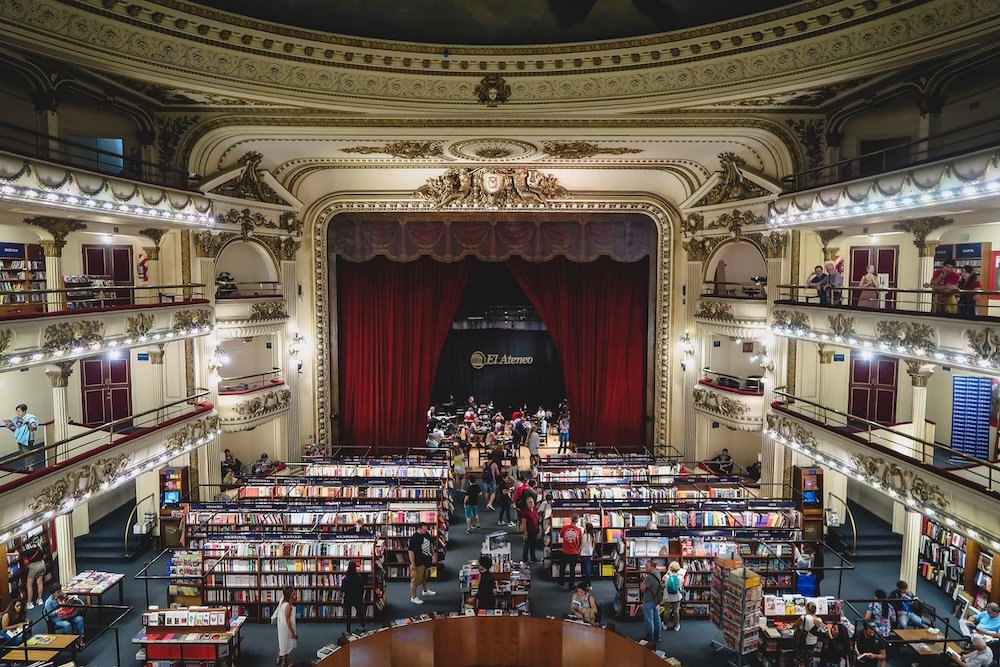
14. Browse books at El Ateneo Grand Splendid
Buenos Aires is a city of bookstores and none is more impressive than El Ateneo Grand Splendid. In fact, just a few years ago, this bookstore was voted the most beautiful in the world!
The bookstore is set in a former theatre, which opened in 1919 as Teatro Gran Splendid. Back then, the theatre had a seating capacity of 1,050 guests and its stage was graced by world-famous tango singers, including the one and only Carlos Gardel.
There are plenty of bookstores in Buenos Aires to visit, but part of the appeal at El Ateneo Grand Splendid is that it still very much looks like a theatre, complete with hand-painted ceiling frescoes, ornate balconies with cozy seating, and some 120,000 books to browse.
You can search through stacks of books, and if you’re looking for a Classic Argentine author, you cannot go wrong with Jorge Luis Borges.
So all in all, a perfect rainy day activity in Buenos Aires, where you can easily spend a few hours.
15. Catch a play on Avenida Corrientes
Maybe you’re looking for things to do in Buenos Aires on a rainy evening? We’ve got you covered there, too!
Avenida Corrientes is known as the ‘street that never sleeps’. This avenue is lined with theatres, pizzerias, cafes, bars and restaurants.
Picture giant billboards, neon signs and plenty of flashing lights. It’s an assault on the senses, but it also presents plenty of options! So why not go to a show?
Some of the more famous theatres along Avenida Corrientes include Lola Membrives, Nacional, Astral, Complejo Teatral La Plaza, Metropolitan and Ópera.
In terms of performances, you can catch comedies, musicals, stand-ups, dramas, tango shows and even children’s programming.
The one catch is that you’ll need to know a bit of Spanish if you want to truly follow the performance.

So there you have it, 15 things to do in Buenos Aires on a rainy day! As you can see, rainy days don’t have to put a damper on your adventures. In fact, they offer the perfect excuse to slow down and discover a more intimate and atmospheric side of the city.
From wandering through historic cafés and opulent palaces to delving into underground tunnels and museums, there are plenty of ways to stay dry while soaking up local culture. Whether you choose to take an Argentine cooking class, go to a tango show, or browse bookstores, you’ll come away with a deeper appreciation for Buenos Aires’ rich past and vibrant present.
So pack an umbrella, embrace the moody skies, and let the city’s indoor treasures inspire you!
GROUP TOURS – If you’d rather join a group tour to travel in Argentina, check out Gadventures.
CAR RENTAL – To explore Argentina beyond the cities, the best way to do so is by renting a car. Discover Cars offers rentals across the country.
BUS TICKETS – Bus travel is a great way to see Argentina. BusBud offers numerous routes.
TRAVEL INSURANCE – Don’t leave on your trip without booking travel insurance. You can get a quote on SafetyWing.
HOTELS – Booking.com offers accommodations to suit all budgets and travel styles.
TOURS – For a variety of tours and activities, have a look at Viator.
